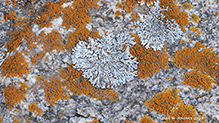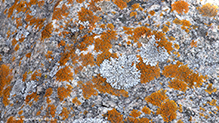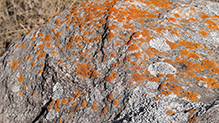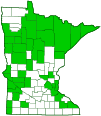Blue-gray Rosette Lichen
(Physcia caesia)
Conservation • Description • Ecology • Distribution • Taxonomy
|
|
||||||||||||||
Description |
Blue-gray Rosette Lichen is a very common and widespread lichen. It occurs worldwide on every continent including Antarctica. It grows mostly on rocks, boulders, and cliffs in open areas, but it also grows on bark. The vegetative body (thallus) is circular or irregular and divided into lobes. It is usually 1″ to 1 3⁄16″ (2 to 3 cm) in diameter, but it can be up to 2¾″ (7 cm) in diameter. It is closely adhered to the substrate, held there by short, black, root-like, anchoring structures (rhizines). It sometimes merges with adjacent thalli, creating what appears to be one large thallus. The lobes are convex and linear. They are usually 1⁄64″ to 1⁄32″ (0.5 to 1.0 mm) wide, but they can be up to ⅛″ (3 mm) wide. The upper side is pale gray, usually becoming slightly darker to much darker in the center. The upper surface is formed of tightly packed, interwoven, fungal threads (hyphae) going in all directions (paraplectenchymatous). Hyphae are the tiny, thread-like structures that make up the body of the fungus. Cortex-free areas of the thallus (soralia), on the margins and sometimes also on the surface, produce bluish-gray, powdery to granular, reproductive growths (soredia). The soralia are often cap-like. The lower surface of the thallus is white to dark gray. Disk-like, spore-producing structures (apothecia) are rare. When present, they are stalkless, prominently rimmed, and up to 1⁄16″ (2 mm) in diameter. They are brownish black, but they are sometimes covered with grayish powder (pruinescence). |
Similar Species |
Ecology |
Substrate |
Rock and sometimes trees |
Growth Form |
Foliose |
Habitat |
Open areas |
Hosts |
|
Distribution |
||
|
Sources |
|
| 3/12/2025 | ||
Occurrence |
||
Very common and widespread |
||
Taxonomy |
|
Kingdom |
Fungi (Fungi) |
Subkingdom |
Dikarya |
Phylum |
Ascomycota (Sac Fungi) |
Subphylum |
Pezizomycotina (Sac Fungi and Lichens) |
Class |
Lecanoromycetes (Common Lichens) |
Subclass |
Lecanoromycetidae (Shield Lichens, Sunburst Lichens, Rosette Lichens, and Allies) |
Order |
Caliciales (button lichens, rosette lichens, and allies) |
Family |
Physciaceae (rosette lichens, frost lichens, and allies) |
Genus |
Physcia (rosette lichens) |
Mycobiont |
Physcia caesia |
Photobiont |
Trebouxia impressa (green algae) |
Subordinate Taxa |
|
Two subspecies and many varieties have been described. Most sources treat these as synonyms or as distinct species, and they do not recognize any subordinate taxa. |
|
Synonyms |
|
Anaptychia caesia Anaptychia stellaris var. caesia Borrera caesia Dimelaena caesia Hagenia caesia Imbricaria caesia Lichen caesius Lichen pulchellus Lobaria caesia Parmelia caesia Parmelia pulchella var. caesia Parmelia stellaris var. caesia Physcia caesia ssp. adscendens Physcia caesia ssp. alpina Physcia caesia ssp. convexa Physcia caesia ssp. plana Physcia caesia ssp. ventosa Physcia caesia var. albonigra Physcia caesia var. caesiella Physcia caesia var. corticola Physcia caesia var. rhaetica Physcia caesia var. ventosa Physcia caesiella Physcia stellaris var. caesia Physcia subalbinea Physcia tribacioides var. caesiella Physcia tribacoides var. caesiella Physcia vainioi Physcia ventosa Physcia ventosa ssp. convexa Physcia ventosa ssp. plana Physcia wainioi Placodium caesium Psora caesia Squamaria caesia Xanthoria caesia |
|
Common Names |
|
Blue-gray Rosette Lichen Powder-back Lichen |
|
Glossary
Apothecium
An open, disk-shaped or cup-shaped, reproductive structure, with spore sacs on the upper surface, that produces spores for the fungal partner of a lichen. Plural: apothecia.
Foliose
Leaf-like; referring to lichens with thin, flat, leaf-like growths divided into lobes which are free from the substrate.
Hypha
A thread-like cell of a fungus that is the main mode of vegetative growth: the basic structural unit of a multicellular fungus. Plural: hyphae. Collectively, the hyphae of a fungus is the mycelium.
Rhizine
A root-like structure of a lichen that attaches the lower layer to the substrate.
Soralium
On lichens, an area on the thallus with no cortex, usually on or near the margin or the tip of a lobe, on which soredia are produced. Plural: soralia.
Soredium
An asexual reproductive structure of a lichen in the form of a tiny dull granule on the thallus surface that can be easily brushed off. It consists of a cluster of algal cells (the photobiont) wrapped in fungal filaments (the mycobiont), but without an outer layer of protective tissue (cortex). Plural: soredia.
Thallus
In lichens: The vegetative body of a lichen composed of both the alga and the fungus. In liverworts: a flat, relatively undifferentiated plant body. Plural: thalli.
Visitor Photos |
||
Share your photo of this lichen. |
||
This button not working for you? |
||
Dan W. Andree |
||
 |
 |
|
 |
|
|
Lichens... This one was on the bottom of that old gravel pit section on a glacial erratic at Frenchman’s Bluff SNA 3-8-25. |
|
|
MinnesotaSeasons.com Photos |
||
|
|
|
|
|
|

Slideshows |
|

Visitor Videos |
||
Share your video of this lichen. |
||
This button not working for you? |
||
|
Other Videos |
||
Stoeprandvingermos - Physcia caesia |
About
Feb 13, 2023 Het stoeprandvingermos (Physcia caesia) is een korstmos uit de familie Physciaceae. Het groeit op basisch steen (zoals beton, cement, baksteen en kalksteen), op geëutrofieerde schors van bomen, op boomvoeten of op andere materialen zoals bewerkt hout, asfalt, etc. De fycobiont (algenpartner) in dit korstmos is Trebouxia impressa. Het is nitrofiet en groeit daarom veelvuldig waar vogeluitwerpselen voorkomen. Google Translate: The curb finger moss (Physcia caesia) is a lichen from the family Physciaceae. It grows on basic stone (such as concrete, cement, brick and limestone), on eutrophied bark of trees, on tree bases or on other materials such as treated wood, asphalt, etc. The phycobiont (algal partner) in this lichen is Trebouxia impressa. It is nitrophyte and therefore grows frequently where bird droppings occur. |

Visitor Sightings |
||
Report a sighting of this lichen. |
||
This button not working for you? |
||
Dan W. Andree |
Location: Frenchman’s Bluff SNA |
 |
Dan W. Andree |
Location: Frenchman’s Bluff SNA This one was on the bottom of that old gravel pit section on a glacial erratic at Frenchman’s Bluff SNA 3-8-25. |
 |
MinnesotaSeasons.com Sightings |
||
|

Created: 3/12/2024 Last Updated: © MinnesotaSeasons.com. All rights reserved. |
